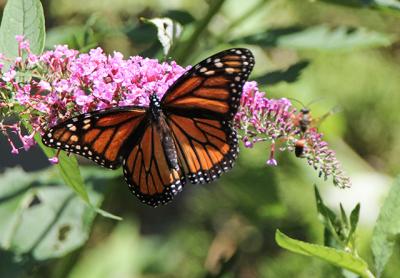Nature Notes: Time for the Butterflies

It’s the end of summer and all matter of flying organisms — bird, bats, dragonflies, and butterflies — are on the wing. On the last evening of August, at least seven nighthawks flew over the Bustamante house on the northeast side of Lake Montauk. Flocks of migrating tree swallows have been swirling around during the past three weeks, migrating and feeding as they go. When a hungry sharp-shinned hawk or merlin comes by, they gather into tight bunches like schools of baitfish trying to elude predators.
Of particular interest in the invertebrate world are the largest migratory insects of them all, the monarch butterflies. Each year at this time, just as butterfly bushes, asters, and goldenrods are blooming, we look for them to flap by with their glorious orange, black-veined wings. They often stop and feed as they go, mostly following the Atlantic Coast dunes on their way to the Jersey coast. Their primary source of nectar on such trips are the seaside goldenrods, which start blooming in September and don’t stop in most years until the middle of October.
Almost every schoolchild knows the story of the monarch: how the female, after mating, lays her eggs, scattering one at a time on a milkweed plant, how the eggs hatch, and how the larvae feed on the poisonous sap of its milkweed host, turning into large yellow and black caterpillars, which after a couple of inches or more of growth pupate into cocoons. In a week or two, the cocoons split open and out comes a large butterfly, not only beautifully adorned, but noxious to the taste. The blue jay that bites a monarch invariably spits it out, and for the rest of its life never tries to feed on one again.
However, for almost a decade now, following a few bumper crops, monarchs have been scarce. Some say it’s because of a partial destruction of their overwintering grounds in the south, particularly in the pine tree-covered mountains of central Mexico. Others say there are fewer and fewer milkweeds to feed on each year. Whatever the reason for their partial demise, we have not seen hordes of them crossing Long Island for a long, long time.
This year may be the beginning of an upsurge, however. As of last Sunday Victoria Bustamante had seen 71. By the same date last year, she had counted only 38, and 55 the year before. Peter Dermody, a hydrogeologist who lives in the Moriches area, has been studying butterflies since he was 7 and each year tries his hand at raising them. He reported seeing about 20 a day for the last few weeks, on his property and elsewhere.
Matthew Galcik, son of the late Walter Galcik, who worked for East Hampton caretaking Shadmoor State Park in Montauk and helping out in the Natural Resources Department for so many years, has made his house on Greenwich Street in Montauk a monarch butterfly oasis. He started two years ago after retiring from his New York City job with the transit authority. He bought several different milkweeds from nurseries and lined them up on his back porch and elsewhere on his property. The first year he had a few monarchs drop by and lay an egg or two. This year the caterpillars on those plants may number 100 or more. Last Friday, Walter, Lois Markle, and I got tired trying to count them all.
The monarch, unlike birds that fly south each fall, is a generational migrator. Adults start out in the south after overwintering and stop to produce young early on. Those young mature and continue the trip north. By the time the last monarch reaches Canada, it may be a great-grandchild of the original one that set out from the overwintering territory.
Like so many other brightly colored insects, several of which lay eggs on milkweeds and close relatives, their colors give them away. They are pungent to the tastebud and would-be predators — frogs, birds, snakes, lizards, and the like — soon catch on. In most cases it only takes one bite to keep a potential predator away for the rest of its life.
The second most populous butterfly here on Long Island, at least as Peter Dermody’s records for this year show, is the American painted lady, also very ornate in orange, black, and yellow hues. It looks a little like a monarch and so may capitalize on the monarch’s foul taste, as does the viceroy butterfly, which is a close mimic of the monarch. We don’t have many viceroys on Long Island, but they are found throughout the United States and southern Canada. On the other hand, the painted lady butterflies occur throughout the world, with the exception of South America. Peter Dermody sees 30 to 50 painted ladies on his butterfly bushes and goldenrods per day.
Hairstreaks, rather small butterflies that may be brightly colored or not, are rare on Long Island, or at least less observed than the bigger, more showy monarchs, viceroys, painted ladies, and swallowtails. Peter Dermody has one around his butterfly bush.
Jean Held, who lives in Sag Harbor and is both a butterfly and dragonfly aficionado, has a hairstreak among her butterflies and she is still trying to determine its exact species.
One of the best places on Long Island to track monarchs on their way south is the Fire Island National Seashore, but almost any dune-y spot along Long Island’s ocean shores will yield results. If you look very closely, you may be able to tell a male from a female. The male has a tiny black dot on each wing where three veins intersect.
Larry Penny can be reached via email at [email protected].
